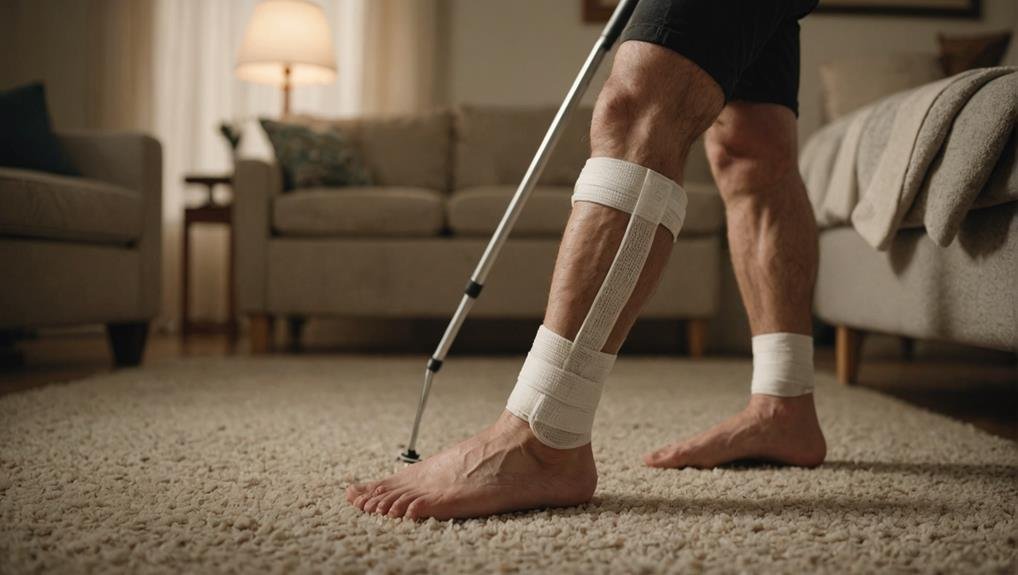When you think about leg injuries, it’s important to understand that they come in various forms, such as fractures, sprains, strains, and dislocations, each with unique causes and complications. Whether you’re an athlete, someone who’s had an accident, or dealing with a medical condition, these injuries can greatly impact your mobility and quality of life. The key to effective treatment is recognizing the type of injury and how it affects different parts of your leg. But what do you do when you suspect a serious injury and every step brings unbearable pain? Let’s explore the critical first steps you should take.
Key Takeaways
- Leg injuries can include fractures, sprains, strains, and dislocations, each affecting different leg parts.
- Common causes of leg injuries include sports activities, falls, accidents, and medical conditions like osteoarthritis.
- Symptoms of leg injuries often involve pain, swelling, bruising, and difficulty moving the affected area.
- Initial treatment generally includes rest, Ice, compression, and elevation (RICE), sometimes requiring medical interventions.
- Prompt medical care and adherence to treatment plans are essential to prevent complications and ensure effective recovery.
Types of Leg Injuries
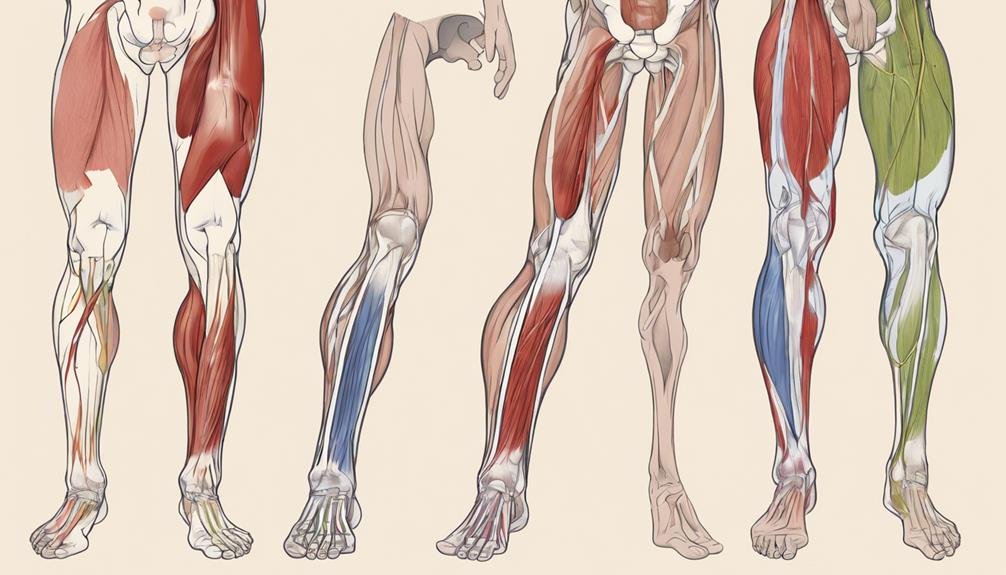
When it comes to leg injuries, there are a range of types that can vary in severity and impact. One common type is fractures, where the bone is broken. Fractures can occur anywhere in the leg, from the hip down to the foot.
Sprains are another frequent injury involving the stretching or tearing of ligaments, the tissues connecting bones at joints. You might experience sprains in areas like your ankle or knee.
Strains, conversely, affect muscles and tendons, the tissues connecting muscles to bones. These injuries involve the stretching or tearing muscle fibers and can be quite painful, often occurring in the thigh or calf.
Dislocations are another type of leg injury in which a bone is pulled out of its joint. They can be particularly serious and typically require immediate medical attention to prevent further complications.
In addition to these, muscle overuse injuries can also occur from repetitive activities, leading to chronic pain and discomfort. Each type of injury can significantly impact your daily activities, causing pain, limited motion, and sometimes more severe complications. Seeking professional medical care is crucial for accurate diagnosis and effective treatment.
Common Causes
Engaging in physical activities is one of the most common reasons for leg injuries. Whether you’re running, playing sports, or simply participating in activities that stress your legs, the risk of injury is always present. Sports activities often involve sudden movements, impacts, and overuse, which can lead to various leg injuries. Falls are another frequent cause. A simple misstep or loss of balance can result in sprains, fractures, or other injuries.
Accidents, whether at home, work or on the road, also contribute significantly to leg injuries. The sudden and often forceful nature of accidents can cause severe harm to your legs. Additionally, certain medical conditions can make you more susceptible to leg problems. Diseases like osteoarthritis can weaken your joints and make injuries more likely. Varicose veins, where veins become enlarged and twisted, can lead to discomfort and increase the risk of leg injuries.
Understanding the specific cause of a leg injury is important for proper diagnosis and treatment. By identifying whether your injury stems from sports activities, falls, or medical conditions, you can take the necessary steps to recover and prevent future incidents.
Affected Areas
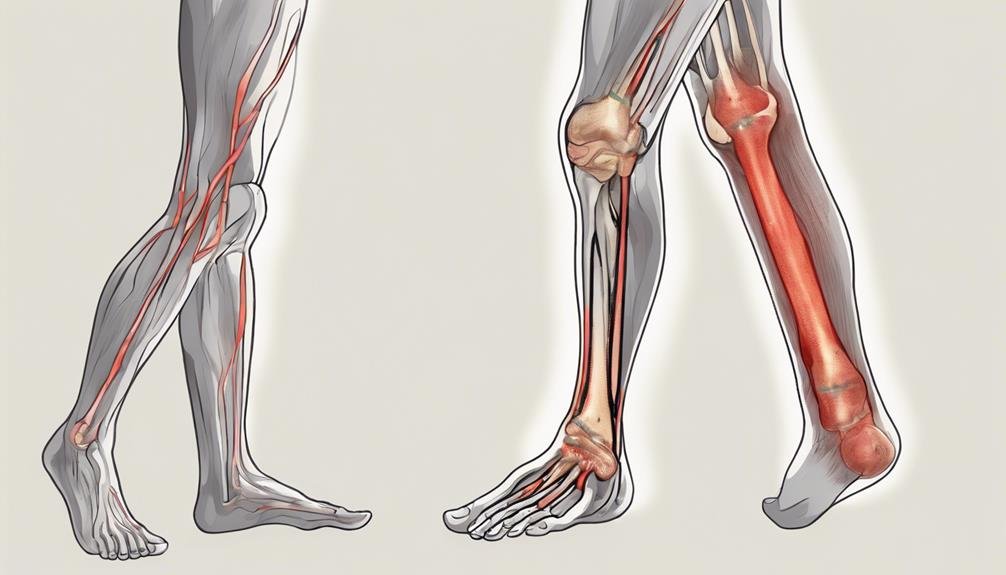
Understanding the affected areas of a leg injury is essential for effective treatment and recovery. When you injure your leg, knowing which parts might be impacted is important. The knee is a common target, where ligaments and tendons can be strained or torn, leading to significant pain and mobility issues.
The femur, the longest bone in the body, is susceptible to fractures, especially in high-impact activities like sports or accidents. The patella, or kneecap, can also be dislocated or fractured, causing immense discomfort and affecting one’s ability to walk.
Additionally, other bones like the tibia and fibula are often involved in leg injuries, sometimes resulting in complex fractures that require extensive healing time.
Leg injuries can be emotionally and physically draining. You might experience:
- Immense pain and discomfort that hinder daily activities.
- Frustration and anxiety over the healing process and potential complications.
- Loss of mobility, making you feel dependent on others.
- Fear of re-injury can deter you from returning to your favorite activities.
Acknowledging these commonly affected areas helps you better understand the nature of your injury and the importance of seeking appropriate medical care.
Complications
Leg injuries aren’t just about immediate pain—they can lead to serious complications if not properly managed. One of the main concerns is the potential development of deep vein thrombosis (DVT). This condition can arise from prolonged immobility and can be life-threatening if a blood clot travels to the lungs. Limited motion is another common issue, often resulting from the injury and the necessary healing process. When you can’t move your leg freely, it significantly impacts your daily activities, making even simple tasks like walking or standing challenging.
Periprosthetic tibial fractures can also occur, especially if you have had a knee replacement or other orthopedic surgery. These fractures complicate the recovery process and often require additional surgical intervention. The pain and difficulty moving your leg can lead to muscle atrophy and further complications.
Furthermore, infections and nerve damage are risks if the injury isn’t properly treated. These issues can prolong recovery and may lead to chronic pain or permanent impairment. Prompt medical care and adherence to treatment recommendations are essential in preventing these complications and ensuring a smoother recovery.
Medical Resources
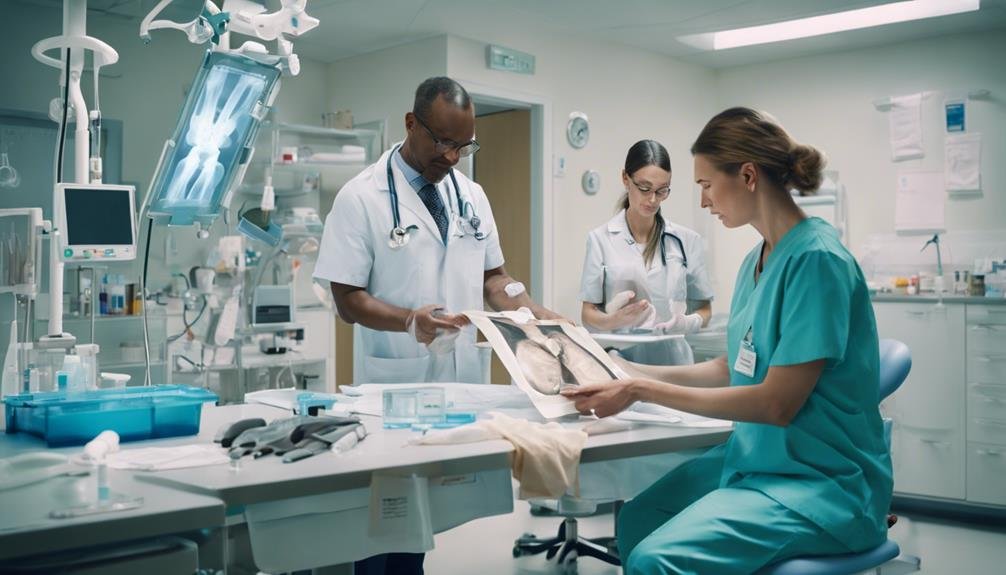
Given the potential complications from leg injuries, accessing dependable medical resources is essential. Leg injuries can range from fractures and sprains to muscle strains and dislocations. Common causes include sports activities, falls, accidents, and certain medical conditions. Seeking medical care promptly is important to prevent complications and guarantee proper treatment.
Professional medical care is vital for an accurate diagnosis and effective treatment of leg injuries. Resources like MedlinePlus and the National Institutes of Health provide valuable health information on leg injuries. These platforms can help you understand your condition and the necessary steps for recovery.
Why You Should Seek Reliable Medical Resources:
- Avoid Misdiagnosis: Inaccurate information can lead to inappropriate treatment.
- Prevent Long-Term Issues: Early intervention can prevent persistent problems.
- Peace of Mind: Knowing you’re following expert advice can reduce worry.
- Speedy Recovery: Proper treatment accelerates the healing process.
Don’t underestimate the significance of professional medical care. Whether it’s a minor sprain or a severe fracture, proper treatment guided by dependable health information can make all the difference in your recovery. Always consult trusted sources and professional healthcare providers for the best outcomes.
Leg Anatomy
A clear grasp of leg anatomy is necessary to understand leg injuries. The leg comprises four key bones: the femur, patella, tibia, and fibula. The femur, the largest bone in your body, connects the hip to the knee, providing essential support and stability.
Your leg muscles, such as the quadriceps and hamstrings, are important for movement and strength. These muscles work together to allow a wide range of motion, whether walking, running, or jumping.
Connective tissue, including ligaments and tendons, plays a significant role in stabilizing your leg joints, ensuring they function smoothly. Ligaments connect bones to other bones, while tendons attach muscles to bones, facilitating movement.
Blood vessels, like arteries and veins, supply oxygen and nutrients to your leg tissues, keeping them healthy and functional. Proper blood flow is crucial for healing and maintaining muscle performance.
Understanding this anatomy helps diagnose and treat leg injuries effectively. Whether dealing with sprains, strains, or more severe conditions, knowing how your leg’s bones, muscles, connective tissue, and blood vessels work together is essential for recovery and maintaining an active lifestyle.
Fractures
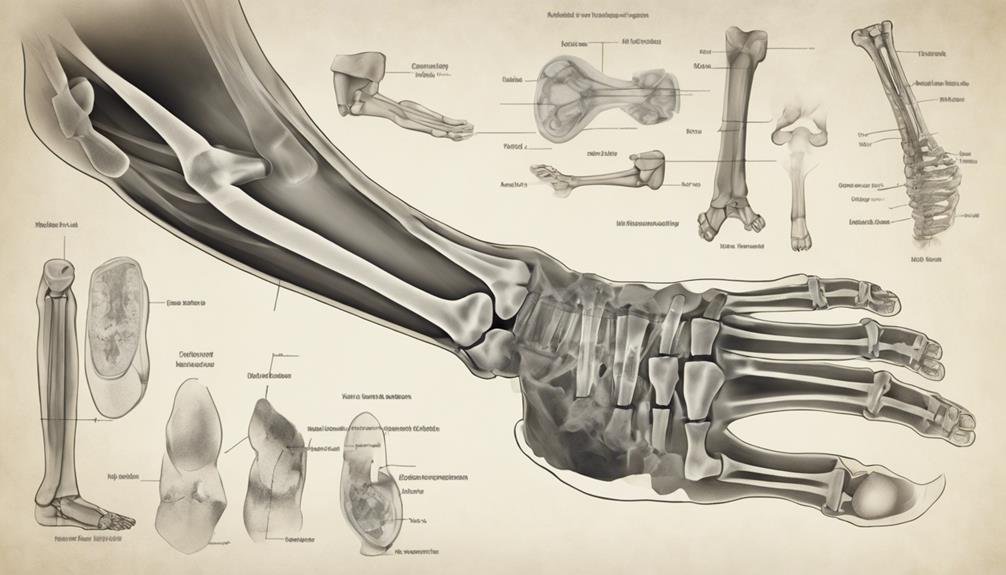
Understanding the complex structure of your leg sets the stage for recognizing and addressing fractures. A leg fracture or broken bone can significantly disrupt your daily life. Fractures often result from falls, impacts, or weakened bones and present with symptoms like pain and swelling, bruising, unusual leg angles, and difficulty standing or moving.
If you suspect a leg fracture, it’s vital to seek medical attention immediately. Doctors usually perform X-rays to diagnose the break and determine the best action. Treatment options vary depending on the severity of the fracture. Simple fractures may only require casting, while compound fractures might need surgery to realign the bones. Some severe cases could even require traction.
Ignoring a leg fracture can lead to complications and prolonged recovery. Prompt and appropriate treatment ensures optimal healing and minimizes long-term issues.
Consider the emotional impact of a leg fracture:
- Pain and discomfort
- Inability to walk or move freely
- The potential need for surgery
- Extended recovery and rehabilitation
Sprains and Strains
When you experience a sprain or strain, you’ll likely notice symptoms like pain, swelling, and weakness. Immediate treatments, such as the RICE method, are essential to manage these injuries. Understanding how to diagnose, treat, and prevent these injuries can greatly aid in your recovery and maintain your mobility.
Symptoms and Diagnosis
Experiencing a leg injury can be both painful and disruptive, and it’s important to identify the symptoms of sprains and strains early on. When you sprain a ligament or strain a muscle, you’ll typically notice immediate pain in the affected area. Swelling often follows, making the injured leg appear puffy and sometimes discolored due to bruising. You might find you have a limited range of motion, struggling to move the joint or muscle without discomfort.
Sprains usually involve the ligaments, the tough bands connecting bones at your joints. These injuries often occur in the ankle.
On the other hand, strains affect the muscles or tendons, which connect muscles to bones, and are common in areas like the hamstrings or quadriceps.
A healthcare provider will perform a physical examination and review your medical history to diagnose these injuries properly. In some cases, they might recommend imaging tests such as X-rays or MRIs to assess the extent of the damage and rule out fractures.
Here’s what you might feel when dealing with a sprain or strain:
- Sharp pain that impedes movement
- Swelling that makes shoes or clothing feel snug
- Bruising that shifts color over time
- A sense of instability or weakness in the leg
Recognizing these symptoms early ensures you get the appropriate treatment and avoid long-term complications.
Immediate Treatments
The first step in dealing with a leg injury is recognizing the symptoms and getting a proper diagnosis. When you’ve sprained or strained your leg, immediate treatment is vital. Start by following the RICE method: Rest, Ice, Compression, and Elevation.
First, Rest the injured leg. It’s crucial to avoid putting weight on it to prevent further damage and allow your body to start healing.
Next, apply Ice to the Iceected area. Use an ice pack for 15-20 minutes every couple of hours during the first 48 hours. This helps reduce inflammation and numbs the pain.
Compression is the third step. Wrap the injury with an elastic bandage or use a brace to stabilize the area. This action minimizes swelling and provides support. Be careful not to wrap too tightly, as it could impede blood flow.
Recovery and Prevention
Recovering from sprains and strains involves more than just initial treatment; it’s about taking proactive steps to guarantee complete healing and prevent future injuries. Initially, you’ll use the RICE method—rest, Ice, compression, and elevation—to reduce pain and swelling. However, your journey to full recovery doesn’t end there.
Physical therapy plays an essential role in your recovery. A physical therapist will guide you through exercises to strengthen and increase the flexibility of the affected area. This helps prevent recurrence and secures your muscles and ligaments heal properly.
When you feel ready, a gradual return to activities is vital. Rushing back can lead to re-injury, so take time to build your strength and confidence. Always listen to your body.
Prevention is key to avoiding future sprains and strains. Incorporate proper warm-up routines and stretching into your fitness regimen. Wearing appropriate protective gear during physical activities can also provide added security. Maintaining good overall physical fitness, including strength and balance training, will further minimize your risk.
Consider these points to stay motivated and focused:
- Reduce pain and swelling: Embrace the RICE method.
- Strengthen and stretch: Follow your physical therapist’s guidance.
- Avoid re-injury: Gradually return to your activities.
- Stay prepared: Warm up, stretch, and use protective gear.
Dislocations
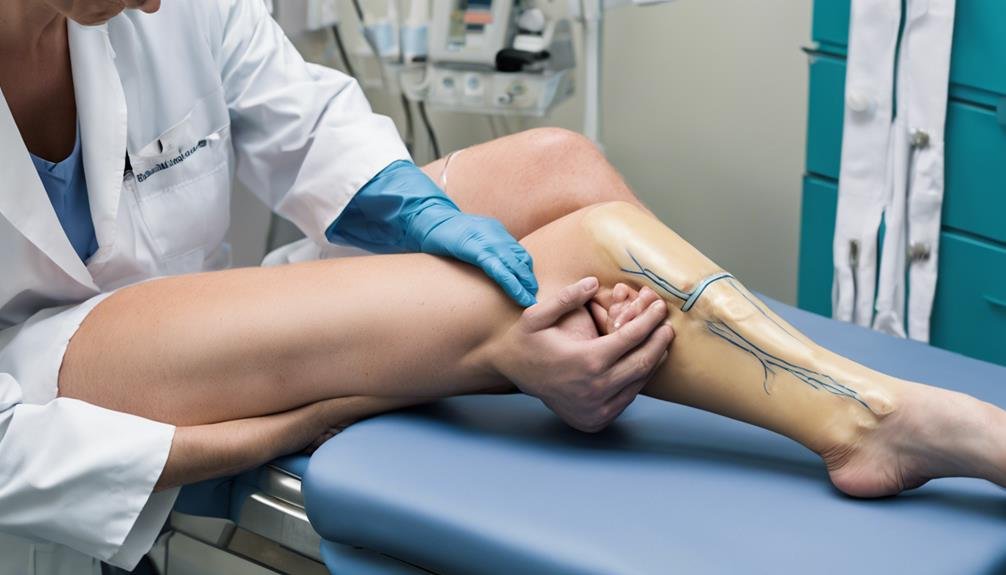
When bones are forcefully knocked out of the joint, dislocations can occur. Most commonly, dislocations affect the only; dislocations affect the shoulder, finger, hip, and knee joints. A dislocated joint is no joke; it brings severe pain and immobility, making even slight movements excruciating.
Hip dislocations, in particular, are notorious for causing additional injuries due to the complex nature of the joint and its surrounding structures. As a result, it’s important to seek immediate medical attention when you suspect a dislocation. Don’t attempt to relocate the joint yourself; doing so might lead to more damage.
You might wonder how to recognize a dislocation. The symptoms are usually hard to miss: intense pain, noticeable swelling, and a visibly deformed joint. These signs cry out for urgent care, and delaying treatment can lead to complications like nerve or blood vessel damage.
Swift action is crucial to guarantee proper realignment and management of the dislocated joint.
Treatment and Care
Dealing with a dislocated joint is only the first step; knowing how to treat and care for leg injuries is equally important. Treatment often begins with the RICE method: rest, Ice, compression, and elevation. This approach helps reduce swelling and pain in the initial stages.
For more severe injuries, such as a torn ACL or a fracture, surgical procedures like ACL reconstruction or fracture stabilization might be necessary.
Pain management is vital for your recovery. Medication, immobilization, and rehabilitation exercises significantly alleviate discomfort and promote healing. Physical therapy is another key component, helping you regain strength and mobility.
Prompt medical care is essential, especially for skin injuries, young children, or life-threatening situations. Don’t delay seeking professional help when needed.
Home care for minor injuries includes using cold and heat packs, taking pain relief medications, and monitoring for worsening symptoms. You should always look for signs that indicate the need for further medical attention.
- Are you feeling overwhelmed by pain?
- Are you worried about long-term mobility?
- Are you concerned about a loved one’s injury?
- Unsure if you need medical intervention?
Your vigilance and proactive care can make all the difference in your recovery journey.
Conclusion
To wrap up, leg injuries can greatly influence your daily life, but comprehending the types, causes, and affected areas assists you in taking the necessary steps toward recovery. Don’t overlook the pain or swelling; seek medical attention promptly to prevent complications. Whether it’s a fracture, sprain, strain, or dislocation, proper treatment and care—such as rest, physical therapy, or surgery—are essential. With the right approach, you’ll be on the road to healing and regaining mobility in no time.
FAQs
What are the common types of leg injuries?
Leg injuries can vary in severity, from minor strains to serious fractures. Common types include:
- Sprains and Strains: These injuries affect the ligaments (sprains) or muscles and tendons (strains). They usually result from overstretching or tearing due to sudden movements.
- Fractures: A break in one of the bones in the leg, such as the femur, tibia, or fibula, often caused by trauma or high-impact accidents.
- Tendonitis is inflammation of the tendons, commonly affecting areas like the Achilles tendon due to overuse or repetitive motion.
- Contusions (Bruises): Caused by a direct blow to the leg, leading to swelling, discoloration, and pain.
- Dislocations: Occurs when a joint, such as a knee or hip, is forced out of its normal position, often due to a fall or impact.
Common Leg Injuries:
- Sprains and strains.
- Fractures (bone breaks).
- Tendonitis (inflammation of tendons).
- Contusions (bruises).
- Dislocations.
What causes leg injuries?
Leg injuries can result from various activities or accidents, including:
- Sports and Exercise: High-impact sports like running, soccer, or basketball can lead to sprains, strains, or fractures from overuse or sudden movements.
- Falls: Tripping, slipping, or falling can cause fractures, dislocations, or contusions, especially in older people or those with balance issues.
- Accidents: Car accidents, workplace incidents, or heavy impacts can lead to serious leg injuries like fractures or dislocations.
- Overuse: Repetitive movements during running, cycling, or weightlifting activities can lead to overuse injuries like tendonitis or stress fractures.
Causes:
- Sports and exercise.
- Falls or slips.
- Accidents or impacts.
- Overuse and repetitive motions.
How are leg injuries treated?
Treatment depends on the severity and type of leg injury, but common approaches include:
- RICE Method: For minor injuries like sprains or strains, the RICE method (Rest, Ice, Compression, Elevation) can help reduce swelling and pain.
- Physical Therapy: After initial healing, physical therapy may be recommended to regain strength, mobility, and flexibility in the injured leg.
- Medications: Over-the-counter pain relievers like ibuprofen or acetaminophen can help manage pain and reduce inflammation.
- Immobilization: Fractures or severe sprains may require a cast, brace, or splint to immobilize the leg and allow the bones or ligaments to heal.
- Surgery: For severe fractures, torn ligaments, or dislocations, surgery may be required to realign bones, repair tissues, or stabilize joints.
Treatment Options:
- RICE method for minor injuries.
- Physical therapy for recovery.
- Pain relievers to manage discomfort.
- Immobilization for fractures or severe injuries.
- Surgery for severe fractures or torn ligaments.
How long does it take to recover from a leg injury?
The recovery time for a leg injury depends on its severity:
- Minor Sprains and Strains: Typically heal within 1 to 3 weeks with rest and proper care.
- Fractures: Recovery can take anywhere from 6 weeks to several months, depending on the location and complexity of the fracture.
- Tendonitis: Recovery usually takes 4 to 6 weeks, but this can vary based on how well the injury is managed and treated.
- Severe Injuries (Surgery): Recovery from surgeries, such as for torn ligaments or major fractures, can take several months to a year, often requiring physical therapy.
Recovery Time:
- Minor injuries: 1 to 3 weeks.
- Fractures: 6 weeks to several months.
- Tendonitis: 4 to 6 weeks.
- Severe injuries (surgery): Several months to a year.
How can I prevent leg injuries?
Preventing leg injuries involves taking care of your body and being mindful of your activities:
- Warm Up and Stretch: Always warm up and stretch before physical activity to improve flexibility and reduce the risk of strains.
- Wear Proper Footwear: Wear supportive shoes designed for your specific activity to prevent overuse injuries and falls.
- Strengthen Muscles: Regular strength training, especially for the legs and core, can help prevent injuries by improving stability and balance.
- Use Proper Technique: When engaging in sports or exercise, use proper techniques to avoid unnecessary strain on your muscles and joints.
- Listen to Your Body: Rest when you feel pain or discomfort, and avoid pushing through injuries, as this can lead to more severe damage.
Prevention Tips:
- Warm up and stretch before the activity.
- Wear proper footwear for support.
- Strengthen leg and core muscles.
- Use appropriate techniques during exercise.
- Rest when feeling discomfort.
